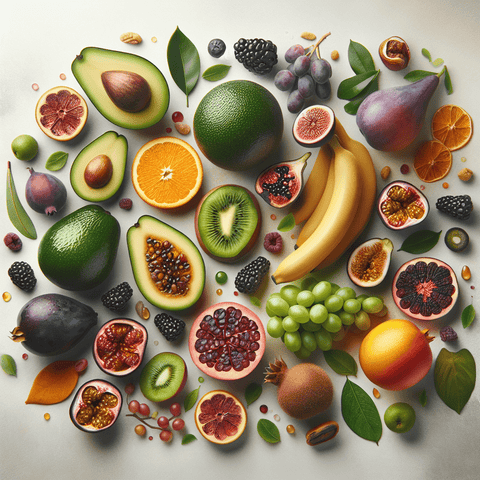Magnesium-Rich Fruit: Unlocking Nature’s Nutritional Powerhouse for Your Health
Magnesium is an essential mineral involved in more than 300 enzymatic processes in the human body, supporting functions such as muscle contraction, nerve transmission, bone development, energy production, and even DNA synthesis. Yet, despite its critical roles, many individuals—especially those consuming heavily processed foods—may not meet daily magnesium recommendations. According to the European Food Safety Authority (EFSA), the average adult’s daily requirement for magnesium is approximately 300-375 mg, depending on age and gender. Though magnesium supplements are widely available and helpful in certain situations, they are not the only source of this vital mineral. A natural and enjoyable way to increase magnesium intake is by incorporating magnesium-rich fruits into your diet. Fruits not only provide magnesium, but they also offer a rich spectrum of vitamins, antioxidants, fiber, and water content, making them ideal for hydration and overall health. As a bonus, the naturally occurring nutrients in fruits can work synergistically to optimize magnesium absorption and utilization. This post will delve deep into magnesium in fruits, explore which ones are the richest sources, and help you incorporate them into your daily routine to support comprehensive wellness.Magnesium Content in Fruits: Understanding the Levels and Benefits
Understanding which fruits contain magnesium is critical for people looking to optimize their intake naturally. While fruits generally don’t top the magnesium charts compared to seeds, nuts, legumes, and whole grains, many do offer modest to substantial amounts of bioavailable magnesium along with a powerhouse of additional nutrients. Let’s explore the average magnesium content present in commonly consumed fruits. Every fruit varies depending on species, ripeness, season, and growing conditions, but average estimations are available through nutritional databases like the USDA and EFSA:- Bananas – ~27 mg per 100g
- Avocados – ~29-30 mg per 100g
- Figs (dried) – ~68 mg per 100g
- Dates (dried) – ~54 mg per 100g
- Kiwi – ~17 mg per 100g
- Blackberries – ~20 mg per 100g
- Passion fruit – ~29 mg per 100g
- Prickly pear – ~85 mg per 100g
- Mulberries – ~43 mg per 100g
- Pomegranate – ~12 mg per 100g
Best Magnesium Fruits: Top Natural Sources for Elevated Magnesium Intake
Let’s explore some of the most well-known and accessible fruits that provide a decent amount of magnesium per serving. These fruits can be eaten fresh, frozen, dried, or blended into smoothies to keep your nutrient intake versatile and enjoyable.Avocados
Avocados are not just a popular source of healthy fats—they are also surprisingly rich in magnesium. A 100g portion of avocado contains approximately 29 mg of magnesium, accounting for roughly 7-9% of the daily recommended intake. In addition, avocados are high in potassium, fiber, and monounsaturated fats. Their high-fat content helps absorption of fat-soluble vitamins like vitamin D and E, making them an excellent addition to any diet. You can slice avocado into salads or mash it into a nutritious guacamole dip. Paired with high-magnesium whole grains like quinoa or brown rice, avocados elevate both flavor and nutrient value.Bananas
Bananas are among the most popular fruits in the world, valued for their convenience, sweetness, and nutrient profile. One medium banana (about 118g) provides roughly 32 mg of magnesium. They also offer abundant potassium, vitamin C, and B6. Bananas are particularly effective as a post-workout snack because they support electrolyte balance and energy. Enjoy bananas on their own, chopped into oatmeal, or frozen and blended into a creamy, magnesium-boosted smoothie. Combined with a source of dietary fat (like nut butter), bananas offer both energy and nutrient density.Dried Figs
Dried figs contain around 68 mg of magnesium per 100g, making them a potent magnesium fruit—especially in dried form where nutrients are more concentrated. They also contain calcium, iron, and fiber and are naturally sweet. Perfect as a snack or added to yogurts and baked goods, figs provide a convenient and nutrient-dense fruit option. When shopping for dried fruits, aim for products without added sugar to keep things healthy and wholesome. They pair well with nuts and seeds for a truly magnesium-rich trail mix.Dates
Dates offer a double benefit: impressive sweetness and decent magnesium content (~54 mg per 100g). Rich in antioxidants, fiber, and minerals like iron and potassium, dates serve as a natural energy booster. A few Medjool dates can be stuffed with almond butter or simply blended with oats and seeds for a healthy energy bite. They are a favorite ingredient in plant-based baking due to their binding texture and natural sugar content.Kiwi
Though modest in magnesium (~17 mg per 100g), kiwi is a star when it comes to vitamin C and fiber. The balance of nutrients makes kiwi a powerhouse fruit in supporting digestion, immunity, and magnesium absorption from other foods. Enjoy kiwi fresh, blended into a morning smoothie, or sliced atop a high-fiber granola bowl. Leave the skin on for extra fiber and antioxidant benefits.Blackberries and Raspberries
Blackberries (~20 mg per 100g) and raspberries (~22 mg per 100g) are low in calories but rich in antioxidants, fiber, and magnesium. They also provide vitamin C and manganese, enhancing enzymatic functions and immune support. Berries can be consumed fresh, frozen, or dried. They're excellent over porridge or plain yogurt or baked into healthy muffins. Add a handful to your fruit salads to give your daily magnesium intake a colorful push. For individuals managing their nutrient intake or augmenting their diet, magnesium fruits offer diverse choices. To ensure you’re meeting all micronutrient requirements, explore synergistic vitamin categories such as Vitamin D or Vitamin K—both of which interact with magnesium to maintain bone health.Fruits with High Magnesium Levels: A Guide to Natural Supplements
Beyond the commonly consumed fruits, several less mainstream fruits provide exceptionally high levels of magnesium. Including these options can help diversify your palate and increase your intake of this vital mineral.Prickly Pears
Also known as cactus fruit or "nopal," prickly pears are native to Central America and the Mediterranean. These fruits are unusually high in magnesium, delivering approximately 85 mg per 100g. In addition to magnesium, they are rich in antioxidants such as betalains and phenolics. The fruit can be eaten raw or turned into juice, jams, and syrups. Peel the skin carefully (avoiding the thorns), chop, and blend for a hydrating beverage. Their rare nutrient profile makes them a valuable addition to a magnesium-friendly diet.Mulberries
Mulberries provide ~43 mg of magnesium per 100g and are nutrient-dense, containing iron, vitamin C, vitamin K, and resveratrol. Dried mulberries make a portable snack rich in energy and minerals. Sprinkle them onto oatmeal, mix into homemade granola bars, or enjoy by the handful. They pair well with seeds for a mineral-rich, energy-boosting combination.Passion Fruits
Delightfully tangy and aromatic, passion fruit delivers ~29 mg of magnesium per 100g along with high fiber, vitamin A, and antioxidants like polyphenols. Just a couple of servings per week can support digestive health and micronutrient intake. Scoop passion fruit into yogurt or smoothies for an exotic twist. Its seeds add a pleasant crunch and extra fiber.Nectarines and Peaches
Nectarines and peaches are softer stone fruits with magnesium contents ranging from 10–12 mg per 100g. While not the richest magnesium providers, they carry other essential compounds like vitamin A, potassium, and polyphenols. Add slices of these fruits to salads, enjoy as fresh snacks, or bake into healthy desserts alongside oats and almonds.Pomegranates
Pomegranates provide roughly 12 mg of magnesium per 100g but are rich in polyphenols, vitamin C, and potassium. The seeds, or arils, can be sprinkled on various meals for a nutrient burst. Combining pomegranates with other magnesium-rich foods enhances both absorption and culinary pleasure.Natural Magnesium Sources: Beyond Supplements—Fruits as a Whole Food Solution
One of the defining benefits of obtaining magnesium from fruits is nutrient synergy. Magnesium supplements can help when there’s a clear deficiency risk, but getting magnesium with other phytonutrients, enzymes, and fiber in fruits ensures better digestion and absorption.Bioavailability and Whole-Food Matrix
Bioavailability refers to how efficiently a nutrient is absorbed and utilized by the body. Fruits offer a 'whole-food matrix’—a compound structure of vitamins, water, and fiber—creating a nourishing environment that optimizes magnesium utilization. For example, vitamin C in kiwi or citrus fruits can ease digestion and increase uptake.Other Nutrients in Fruits
Many magnesium-rich fruits contain complementary nutrients such as:- Potassium – for heart and muscle health
- Vitamin C – for antioxidant defense and collagen production
- Vitamin K – for bone metabolism
Magnesium Fruit Chart: Visualizing Magnesium Content Across a Range of Fruits
Here’s a concise summary of magnesium content per 100g of various fruits:| Fruit | Magnesium (mg per 100g) |
|---|---|
| Prickly Pear | 85 mg |
| Dried Figs | 68 mg |
| Dates | 54 mg |
| Mulberries | 43 mg |
| Avocados | 29 mg |
| Passion Fruit | 29 mg |
| Bananas | 27 mg |
| Blackberries | 20 mg |
| Raspberries | 22 mg |
| Kiwi | 17 mg |
| Pomegranates | 12 mg |
Incorporating Magnesium-Rich Fruits into Your Nutritional Supplement Routine
Integrating magnesium-rich fruits into your daily nutrition can reinforce your supplement efforts and enhance micronutrient intake without complications.Serving Suggestions
A typical serving size (100g) can be achieved by eating one medium banana, one avocado half, a handful of berries, or three to four dried figs. Mixing fruits ensures you hit a variety of nutrient targets.Magnesium-Rich Combos
- Morning Smoothie: Banana, kiwi, berries, spinach, almond milk
- Midday Salad: Avocado, orange slices, kale, quinoa
- Snack Mix: Dried figs, dates, mulberries, pumpkin seeds
Try This Recipe
Magnesium Boost Smoothie Blend together: - 1 banana - ½ avocado - ½ cup raspberries - 1 tbsp chia seeds - 1 cup spinach - 1 cup coconut water This powerhouse blend offers magnesium from multiple ingredients, along with potassium, hydration, and antioxidants.Final Thoughts: Choosing the Right Magnesium Source for Your Health Goals
Fruits offer a natural, effective, and delicious way to increase your daily magnesium intake. While supplements offer precision targeting of deficiencies, natural sources contribute to long-term health optimization thanks to their complex nutritional make-up. When should you consider supplements instead of food? If you're facing a diagnosed deficiency, absorption issues, or require larger doses under medical advice, supplements are key. Learn more through our full magnesium solution category here. However, for most healthy individuals looking to maintain nutrient balance, fruits can be an optimal and sustainable solution.Q&A Section
Q: Which fruit has the highest magnesium content?A: Prickly pear offers the highest magnesium per 100g among common fruits, providing around 85 mg. Q: Can magnesium from fruits replace supplements?
A: Fruits can significantly contribute to magnesium intake, but severe deficiencies might still require supplements. Q: Can eating too much magnesium from fruits be harmful?
A: Not likely. Magnesium from fruits comes in moderate doses and is self-limiting due to their fiber and water content. Q: What’s the best time to eat magnesium-rich fruits?
A: Anytime—morning smoothies, afternoon snacks, or desserts. Spread intake throughout the day for optimal absorption. Q: Are dried fruits better than fresh fruits for magnesium?
A: Dried fruits contain concentrated nutrients, including magnesium, but should be eaten in moderation due to natural sugars.



